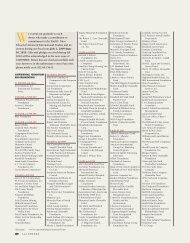Download Current Issue - SAIS
Download Current Issue - SAIS
Download Current Issue - SAIS
You also want an ePaper? Increase the reach of your titles
YUMPU automatically turns print PDFs into web optimized ePapers that Google loves.
When, as a result of market reforms,<br />
agricultural productivity began to rise<br />
steeply in the early 1980s, surplus labor<br />
began to move away from the farm, first<br />
to emerging rural industries—usually<br />
collectively owned—in nearby towns<br />
and later, from the early 1990s, to the<br />
big cities in eastern China, where the<br />
demand for cheap labor was exploding.<br />
China’s total migrant population living<br />
in urban areas, often without access<br />
to subsidized urban services such as<br />
health and education (because many<br />
lack a permanent urban registration<br />
certificate, or hukou), is estimated at<br />
175 million. The share of agricultural<br />
employment in China today is about<br />
one-third, roughly the same as in Japan<br />
in 1960 and South Korea in 1970. The<br />
migration of agricultural surplus labor<br />
to higher-productivity jobs will continue<br />
for at least another decade, supporting<br />
high economic growth for the<br />
country as a whole.<br />
Food Security and International Trade<br />
China’s traditional preoccupation with<br />
food security—which means grain selfsufficiency—is<br />
more easily understood<br />
when one realizes the country’s share of<br />
the world’s arable land and freshwater<br />
resources (7 percent in both instances)<br />
is only a fraction of the country’s share<br />
of the global population (20 percent).<br />
Joining the WTO was a breakthrough<br />
of historical importance for China and<br />
the world for many reasons, including<br />
confirmation of China’s willingness<br />
to increase its dependence on international<br />
trade for food security. Most<br />
agricultural trade, both imports and<br />
exports, is now relatively unrestricted.<br />
But for basic food grains, including<br />
wheat, corn and rice, China continues<br />
to aim at 95 percent self-sufficiency.<br />
The recent surge in corn imports,<br />
however, suggests Beijing is willing to<br />
compromise.<br />
Increased reliance on imports for<br />
wheat and corn is in the country’s<br />
long-term interest. Those grains are<br />
mostly grown on irrigated fields in<br />
northeastern China, where the shortage<br />
of surface and groundwater has become<br />
acute. China has no comparative<br />
advantage in the production of those<br />
grains, as it has for rice. Rice yields<br />
in irrigated fields in southern China,<br />
where water resources are still relatively<br />
abundant, are typically among the highest<br />
in the world.<br />
It would be better for China—and<br />
for the world—if it used scarce water<br />
resources in the Northeast for the production<br />
of fruits, vegetables, fish and<br />
poultry (products that typically require<br />
much less water and land per dollar of<br />
value added than course grains) and<br />
exported those products to pay for grain<br />
imported from Argentina, Canada, the<br />
United States and other countries that<br />
do have a comparative advantage.<br />
China should also use more “virtual<br />
water” embedded in imported grains<br />
and other products. (For an explanation<br />
of how trade in virtual water can<br />
help alleviate regional water shortages,<br />
see “Water and Development”<br />
by this author in the 2008 issue of<br />
<strong>SAIS</strong>PHERE.)<br />
By joining WTO and opening to<br />
international trade in agricultural<br />
products, China can make more efficient<br />
use of scarce water resources in<br />
the Northeast, home to more than 300<br />
million people—and thereby achieve<br />
higher income growth for farmers and<br />
more jobs in horticulture and animal<br />
husbandry, a win-win for all.<br />
Agriculture Versus Urban Development<br />
Preserving agricultural land is an ongoing<br />
struggle in China, especially in light<br />
of the claim on land for urban development.<br />
As in Hong Kong, there is no<br />
private land ownership in (mainland)<br />
China. Since 1987, urban land, owned<br />
and administered by local governments,<br />
has been made available on the basis<br />
2011–2012 19



